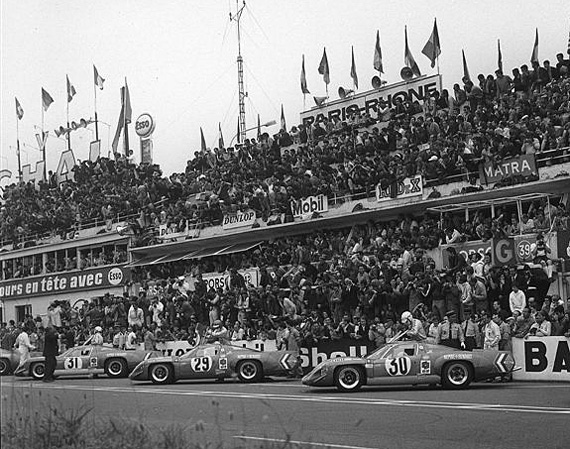
Le Mans 1969, from left:#31 Alpine A220-1731(1968)for Jean-Pierre Nicolas- Jean-Luc Thérier, #29 Alpine A220-1736(1969) for Patrick Depailler-Jean-Pierre Jabouille, #30 Alpine A220-1734 (1969) for Henri Grandsire- Jean-Claude Andruet
Story by Roberto Motta
Historic images courtesy Renault Communications
Scroll to read in the Italian language
In the 1960s, thanks to the financial support of Renault, Alpine created several cars with which it managed to win the class win at the 24 Hours of Le Mans. The Alpine M63, M64, M65 and A210 were particularly competitive and reliable enough to obtain class victories numerous times as well as do well in the energy performance and index performance awards.
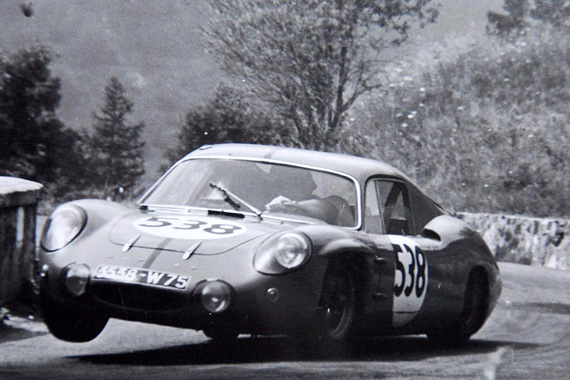
The Alpine M64 of Roger de Lageneste at Sestrieres in 1964. This car is the development of the M63 with slightly redesigned bodywork.
As time went on, Alpine desired to create a car with an engine of larger displacement, so that in 1966, Renault commissioned Gordini to do a study of a new V8 engine. In February of 1967, Renault officially approved the design of the new V8 called ‘ T62 ‘, and the first tests on the dyno began in the summer of the same year.
The ‘ T62 ‘ was conceived to also function for possible road use. Featuring bore and stroke measurements of 87.0 and 63.0 mm (2995 cc), it used a 2 valve head, and twin cams on each bank. It was powered by four twin-choke downdraft Webers, and according to the engineers, produced some 300-310 hp at 7800 rpm. In fact it was subject to strong vibrations and it was advised not to exceed 7000 rpm, so the power was about 280 hp.
Le Grand- Mère
After the V8 Gordini was mounted on the chassis of a modified 210 A, and the car was called the A211. Because it used the old 210 Chassis number 1727, was dubbed the Grand- Mère (the grandmother).
The A 211 was unveiled at the Paris Motor Show in the presence of the Head of State General Charles de Gaulle, and made its debut in the race on October 15th in the 1,000 km of Paris. Entrusted to Mario Bianchi and Grandsire finished the race in a promising 7th position.
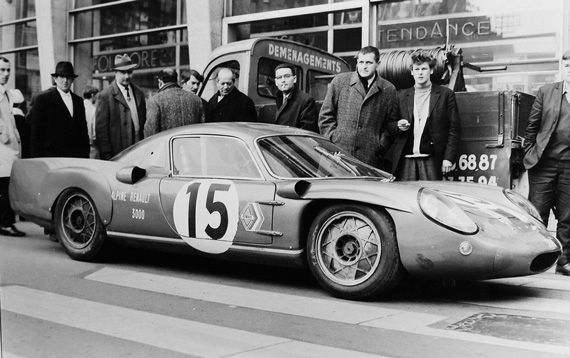
The A211 (Le Grand- Mère) on its debut viewing prior to its first race at Montlhéry. It proved to be cumbersome, but it was a development car and it led to another new design.
To decrease the high speeds reached by cars at Le Mans at the end of the ’67 season the FIA issued new regulations that provided for the limitation of the displacement of the engines 3 liters. Suddenly the Alpine Gordini could potentially compete for absolute victory. (In reality, a new class of sports prototypes was created allowing cars like the 4.5 liter Porsche 917 to compete, thus making a mockery of the 3 liter class.)
It was clear, however, that the Alpine could never compete in class with Ferrari, Matra and Porsche whose cars were capable of supplying power above 400 hp. Nevertheless, at the beginning of ’68, because of the change in the top management that left the Alpine responsibility of the racing department, (which until then was the responsibility of the leadership Renault) it was decided to build a new car that took the name A220.
While the development of the new car progressed, the ‘Grand-Mere’ A 211 took part in the 12 Hours of Sebring, the 1000 km of Monza, the 1000 km Nürburgring, the 1000 km of Spa, and finally the 1000 km Zeltweg.
The A 220
The new car was born from the collaboration of Richard Bouleau , André De Cortanze , Marcel Hubert , André and Henri Renut Gauchet. The chassis of the car was small diameter tubes that were part of a multi-tubular chassis of larger diameter.
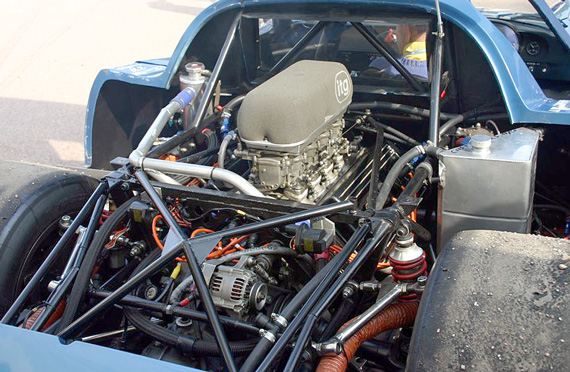
The Gordini engine, Type T 62, is powered by four downdraught Weber 46 IDA. In 1969 the ‘T62’ was able to develop 310 bhp at 8,000 rpm. Roberto Motta photo.
The engine was revised, and adopted the name ‘ T62A ‘. Featuring bore and stroke measurements of 85.0 and 65.0 mm (displacement 2996 cc), it was powered by 4 downdraft twin choke Weber 46 mm. After the first tests, followed by some small updates, the A220 chassis 1730 debuted in the qualifying rounds of the 1000 km of Monza ‘68. Entrusted to Bianchi and Grandsire, set off with the 8th qualifying time and finished the race without being classified.
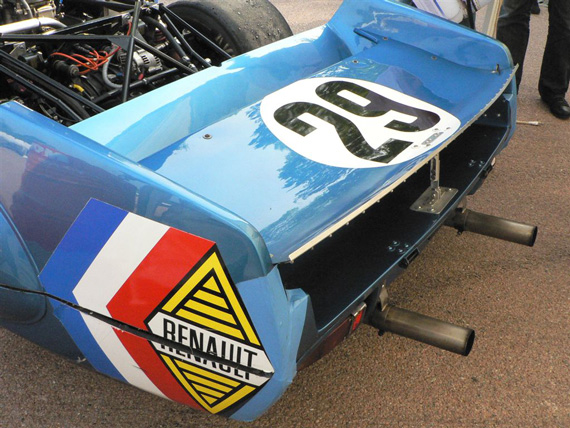
The water radiators were moved to the tail section of the car and the bodywork was redesigned to provide large air intakes behind the doors. Roberto Motta photo.
That year, because of the famous Parisian protests of May 1968, the 24 Hours of Le Mans was postponed until September. Even the workers at Alpine participated in the strike except the racing department’s technicians who continued their activities and continued the preparation of racing cars.
During the tests the 1000 km of Nürburgring on May 19, the A220-1730, enrolled for Whites and Grandsire, had a scary incident . While it was being driven by Grandsire, it did a complete loop then crashed badly.
In the following months at Dieppe, four chassis were set up and the race of Le Mans and the A220 was subjected to a series of tests on the runway of the aerodrome Paluel, on the track of Michelin Ladoux, and on the circuits of Zolder and Monza.
On August 25, at the 500 km Zeltweg, A220-1731 was entrusted to Mauro Bianchi and André de Cortanze but was forced to retire after 27 laps due to a broken oil tank. Despite the various tests and the few changes made to the French engineers was clear that the A 220 had not yet reached the reliability necessary for 24 hours.
Finally, Le Mans
On 28 and 29 September, at the long-awaited 24 hours, the Alpine -Renault lined up as many as 11 cars, including four A220s:
Car number 27, chassis 1732 for Bianchi and Depailler; forced to retire on lap 257 due to a fiery accident while it was driven by Bianchi.
Car number 28, chassis 1733, for Grandsire and Larrousse; with the 11th time, it was also destroyed in an accident, caused by the loss of a wheel, in the course of the 59th lap.
Car number 29, chassis 1731 for Guichet and Jabouille; started from 18th place on the grid, but was forced to retire with electrical problems during the 185 lap race.
Car number 30, chassis 1734 for Cortanze and Vinatier; earning the 15th fastest time, after 297 laps completed the race in 8th place, with less than 34 laps from the Ford GT40 of Rodriguez – Lucien Bianchi.
After the poor showing of Le Mans, the A220 had its revenge in the 1000 km of Paris, where on October 20, driven by André de Cortanze, the A220 achieved its first victory in the Grand Prix Casablanca in Morocco, but it was not a world championship event.
Part 2 chronicles the final trials of the A220.
If you would like to read more about the Alpine Prototypes, be sure to read Roy P. Smith’s book, “Alpine and Renault, the sports prototypes” available from www.velocepublishing.com
In Italia
L’HISTOIRE DU DERNIER MONSTRE BLEU : LE MAGNIFIQUE ALPINE RENAULT A 220 DANS LES COMPETITIONS
Testo di Roberto Motta
Foto di Roberto Motta e Archivio Renault communication
L’Alpine Renault A 220 non ha avuto fortuna nelle competizioni ma, la sua linea filante e le morbide curve della sua carrozzeria hanno saputo far sognare i tifosi.
Negli anni ’60, grazie al supporto finanziario della Renault, l’Alpine realizzò diverse vetture con cui riuscì a conquistare la vittoria di classe nella 24 ore di Le Mans. Le piccole Alpine M63, M64, M65 e A210 erano particolarmente competitive e affidabili tanto da aggiudicasi numerose volte la vittoria nelle classifiche di rendimento energetico e d’indice delle prestazioni.
Col passare del tempo, nacque quindi nella dirigenza Alpine la volontà di realizzare una vettura dotata di un propulsore di maggiore cilindrata, cosicché nel ‘66, commissionò a Gordini lo studio di un nuovo propulsore V8.
Gordini decise di orientare i suoi studi verso la realizzazione di un propulsore da 3,0 litri, e pensò di vincolare al basamento il blocco cilindri di due propulsori da 1,5 litri.
Nel mese di febbraio del ’67, prese ufficialmente il via il progetto del nuovo V8 denominato ‘T62’, mentre i primi test al banco prova iniziarono nell’estate dello stesso anno.
Il ‘T62’ fu concepito anche in funzione di un possibile uso stradale, e prevedeva l’utilizzo di un basamento Renault, al quale erano vincolate testate di alluminio realizzate da Gordini. Caratterizzato da misure di alesaggio e corsa di 87,0 e 63,0 mm (2995 cc), sfruttava una distribuzione a 2 valvole per cilindro, e distribuzione a quattro alberi a camme in testa. Era alimentato da quattro carburatori a doppio corpo verticale Weber 40, montati al centro della V formata dal blocco cilindri e, a detta dei tecnici francesi, erogava una potenza di 300-310 cv a 7800 giri. In realtà era soggetto a forti vibrazioni che consigliavano di non superare i 7000 giri, quindi la potenza utilizzabile era di circa 280 cv.
‘La Grand-Mère’
Dopo che il V8 Gordini ebbe superato i test al banco, venne montato sul telaio di una A 210 opportunamente modificato.
La vettura fu denominata A 211, e per sottolineare il fatto che sfruttava il vecchio telaio della A 210-1727, venne soprannominata la ‘Grand-Mère’ (la nonna).
La A 211 fu presentata al Salone di Parigi alla presenza del Capo dello stato Generale Charles de Gaulle, e debuttò in gara il 15 ottobre nella 1000 km di Parigi. Affidata a Bianchi e Grandsire terminò la gara in 7a posizione.
Alla fine della stagione agonistica ’67, per diminuire le alte velocità raggiunte dalle vetture a Le Mans, la FIA emanò dei nuovi regolamenti che prevedevano la limitazione della cilindrata dei propulsori a 3 litri, così l’Alpine si trovò, potenzialmente, a competere per la vittoria assoluta.
Era tuttavia chiaro, che l’Alpine non avrebbe mai potuto competere con Ferrari, Matra e Porsche le cui vetture erano dotate di propulsori nati espressamente per le competizioni e in grado di erogare potenze superiori ai 400 cv. Tuttavia, all’inizio del ’68, complice anche il cambio ai vertici dirigenziali che lasciava all’Alpine la responsabilità del reparto corse (responsabilità che fino ad allora era di competenza della dirigenza Renault) venne deciso di realizzare una nuova vettura che assunse il nome di A 220.
Mentre procedeva lo sviluppo della nuova vettura, la ‘Grand-Mère’ A 211 prese parte alla 12 ore di Sebring, alla 1000 km di Monza, alla 1000 km del Nürburgring, alla 1000 km di SPA, e lasciò definitivamente il testimone alla A 220 alla 1000 km di Zeltweg.
La A 220
La nuova vettura nacque dalla collaborazione di Richard Bouleau, André De Cortanze, Marcel Hubert, André Renut e Henri Gauchet.
Il telaio della vettura era costituito da una struttura realizzata con tubi di piccolo diametro che si inserivano in un telaio multitubolare di diametro maggiore.
Il propulsore fu rivisto, e adottò la denominazione ‘T62A’. Caratterizzato da misure di alesaggio e corsa di 85,0 e 65,0 mm (cilindrata di 2996 cc), era alimentato da 4 carburatori doppio corpo verticali Weber da 46 mm. Dopo le prime prove cui seguirono alcuni piccoli aggiornamenti, la A 220 realizzata sul telaio ‘1730’ debuttò nelle prove di qualificazione della 1000 km di Monza del ’68. Affidata a Bianchi e Grandsire, partì con l’8° tempo di qualificazione e terminò la gara senza classificarsi.
Quell’anno, a causa delle famose contestazioni parigine del maggio ’68, la 24 ore di Le Mans fu rinviata a settembre.
Anche le maestranze dell’Alpine parteciparono alle agitazioni tranne il reparto corse i cui tecnici continuarono le loro attività e proseguirono la preparazione delle vetture da competizione.
In occasione delle prove della 1000 km del Nürburgring del 19 maggio, la A 220-1730, iscritta per Bianchi e Grandsire, ebbe un pauroso incidente. Mentre era condotta Grandsire, superando un dosso, decollò e fece un ‘loop’ completo per poi schiantarsi rovinosamente al suolo.
Nei mesi successivi, a Dieppe, furono allestiti 4 telai e in vista della gara di Le Mans e la A 220 venne sottoposta a una serie di test sulla pista dell’aerodromo di Paluel, sulla pista della Michelin di Ladoux, e sui circuiti di Zolder e Monza.
Il 25 agosto, in occasione della 500 km di Zeltweg, la A 220-1731 venne affidata a Mauro Bianchi e André de Cortanze: partita con il 4° tempo, fu costretta al ritiro dopo 27 giri di gara per rottura del serbatoio dell’olio.
Nonostante i vari test e le poche modifiche apportate, per i tecnici francesi fu chiaro che la A 220 non aveva ancora raggiunto quella affidabilità necessaria per concludere una 24 ore.
Finalmente Le Mans.
Il 28 e 29 settembre, in occasione della tanto attesa 24 ore, la Alpine-Renault schierò ben 11 vetture, tra cui quattro A 220: la numero 27, telaio 1732, per Bianchi e Depailler. Partita con l’8° tempo fu costretta al ritiro al 257° giro a causa di un pauroso incidente mentre era condotta da Bianchi.
La vettura n° 28, telaio 1733, per Grandsire e Larrousse, partita con l’11° tempo venne ugualmente distrutta in un incidente, causato dalla perdita di una ruota, nel corso del 59° giro. La A 220 n° 29, telaio 1731, per Guichet e Jabouille, partita dal 18° posto della griglia di partenza, fu costretta al ritiro per problemi elettrici nel corso del 185° giro di gara. Infine, la vettura n° 30, telaio 1734, per affidata a de Cortanze e Vinatier, partita con il 15° tempo, dopo aver effettuato 297 giri del circuito concluse la gara all’8° posto, a ben 34 giri dalla Ford GT40 di Rodriguez – Lucien Bianchi.
Dopo la brutta figura di Le Mans, la A 220 ebbe la sua rivincita alla 1000 km di Parigi, dove ottenne il 4 e 6 posto assoluto, poi, il 20 ottobre, condotta da André de Cortanze, ottenne la sua prima vittoria nel Grand Prix de Casablanca in Marocco, gara non di campionato.
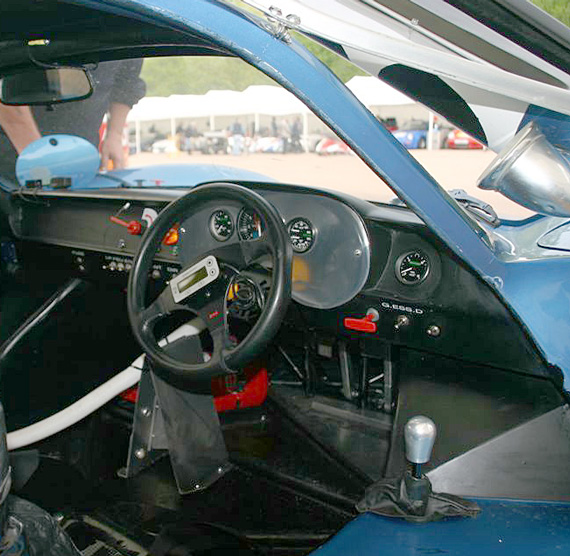
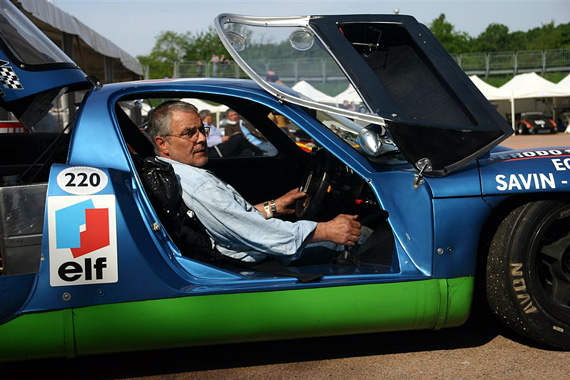
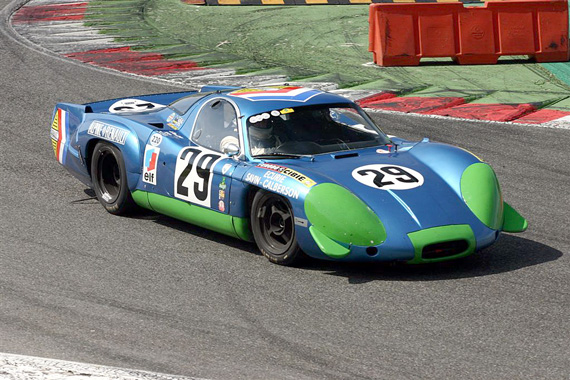
Can’t remember an Alpine Renault driver called “White”, there was however Mauro Bianchi, who was a works driver with Alpine and brother to 1968 Le Mans winner Lucien Bianchi ( with Pedro Rodriguez).
Could this “White” been a unnecessary translation of “Bianchi”?
Roger, you are correct, White is Bianchi. We have corrected the errror, thanks!
The Editor